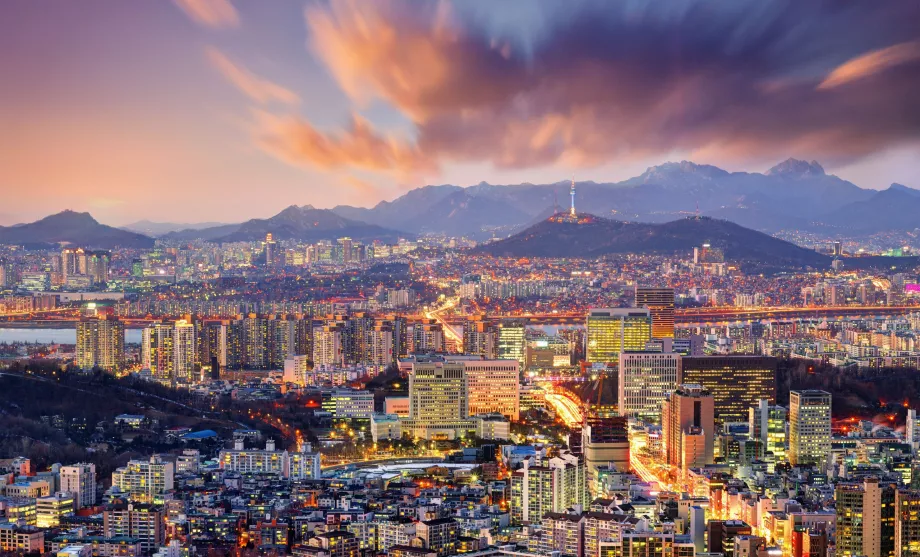Weather in Seoul and best time to go

The Korean peninsula has a very specific climate, and Seoul, surrounded by mountains, is especially so. The city lies in a temperate climate zone and is influenced by the humid continental climate. However, the proximity of the sea also has a significant influence on the weather.
Seoul enjoys four seasons: spring, summer, autumn and winter. However, the differences between temperatures can be extreme, ranging from -12°C in winter to +32°C in summer. Similarly, the humidity in the summer is very high, while the winter air tends to be quite dry.
Temperatures during the year
What is the weather like in Seoul during the different months of the year? Read more...
Weather in January
January is the coldest month in Seoul and the weather is strongly influenced by the Siberian climate. The air is dry and there is often a cold northwest wind, but the sun also shines frequently and the weather is generally nice.
Temperatures can be troublesome, averaging around -5 °C, but often dropping below -12 °C. Snow showers occur about once every 4 to 5 days, but snow is rarely a major inconvenience. In Seoul, it is more of a dusting, at most a few centimetres.
Weather in February
Temperatures rise only slightly during February and can still drop below -10 °C. However, temperatures between 0 and 6 °C and frequent partly cloudy or even clear weather are the norm.
Snow appears about once a week, but it usually doesn't last long on the streets of Seoul. However, some routes in the Bukhansan Mountains remain inaccessible.
Weather in March
In March, the cold slowly goes away, but warm clothing is still a must. Average temperatures rise to 11°C, but especially at the beginning of the month it is still often freezing and occasionally snowing.
At the end of March, cherry blossoms, one of the main attractions when travelling to Korea, start to blossom.
There is little rain and partly cloudy skies for most of the month.
Weather in April
April is one of the main travel seasons in Seoul, mainly because of the cherry blossoms and other trees that create beautiful scenery.
Temperatures hover around a pleasant 18°C, the air is relatively dry and skies are mostly partly cloudy. It rains about 8 days a month, but the rain is more in the form of short and not too heavy showers.
Weather in May
May is also one of the good months to visit. Temperatures are pleasant at around 23 °C, and the humidity increases but does not yet reach uncomfortable levels.
It rains relatively often (on average 9 days per month), but mostly only in the form of quick showers. Occasionally, however, the sky may be overcast for several days at a time, without rain.
Weather in June
The first half of June is still similar to May and the weather is relatively pleasant with occasional showers and temperatures reaching 25 °C.
However, from the second half of June onwards, the weather starts to deteriorate: the monsoon rains arrive. Humidity increases rapidly and average temperatures hover around 28 °C. Rain occurs on average 10 days a month.
Weather in July
July is the rainiest month in Seoul and one of the least suitable for visiting. Temperatures average 29 °C and there is high humidity, a very unpleasant combination for being outdoors.
The skies are often completely overcast and the thunderstorms that occur roughly every other day in the afternoon or evening can be very strong and last for 2 to 3 hours.
Weather in August
Don't plan a trip to Seoul during August either. August is the hottest month with temperatures around 30°C and high humidity. Staying outdoors is extremely uncomfortable, not helped by frequent and very strong thunderstorms.
Weather in September
September sees the rainy season and summer fade away. The humidity is still very high and temperatures do not drop below 26 °C.
There is less rain than in July or August, but heavy thunderstorms still occur about 9 days a month. There are often cloudy skies, but the sun does shine more often than in the summer holidays.
Weather in October
During October, the summer season with its tropical blast goes away and the cooler and much drier air blowing in from the Asian mainland again has the main say.
Temperatures drop to a comfortable 20°C, with the least rain of the year (5 days per month on average), and even then only in the form of short showers.
The end of October is the most colourful month of the year, when autumn is in full swing. Seoul's many forests and parks turn deep reds, bright yellows and dark browns, and walking around the city takes on an indescribable charm.
The weather in November
November is also a great month to visit. At least in the first half of the month, nature is still beautifully colourful and temperatures range between 11 and 13°C. They then drop below 10 degrees towards the end of the month.
The air is dry, with only a few showers and mostly clear or partly cloudy skies.
Weather in December
December is the first month of winter, but don't be afraid to visit. Temperatures are not as drastic as in January and usually range between -5 °C and +5 °C. Extremes below -10 °C can occur, however.
Snow will appear roughly every 4th to 5th day and will not particularly affect your stay outdoors.
Table of temperatures during the year
Soul - Weather and temperatures during the year
When to go to Seoul
Although Seoul is in a temperate zone and one would expect summer to be the high season here, it is just the opposite. Summer (mid-June to late September) is the least suitable time to visit Seoul.
Tropical conditions prevail during summer: high humidity, high temperature, violent thunderstorms and often cloudy skies.
The best time of year is definitely late March to late April, when Seoul and its surroundings are in cherry blossom, the weather is partly cloudy and temperatures are in the comfortable range of 15 to 22 °C.
Compare prices for flights to Seoul
The other main season is October and November, when the weather is also nice and rainy. The countryside is colourful with autumn leaves and temperatures are pleasant around 12 to 20 °C.
If you don't mind the cold, travel even in winter, when the weather is surprisingly sunny with a magical dusting of snow.
Any questions left?
If you have any questions or comments about the article...

